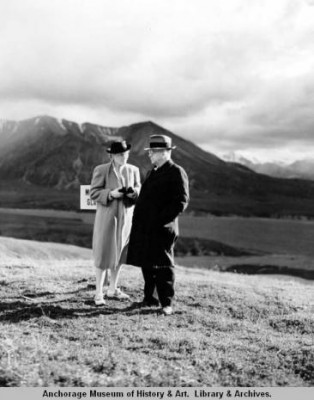Why did Alaska deny asylum to Jewish refugees during WWII?
by Jamie Gonzales |

Jordan Norquist, senior history and German major, is part of the Bear Tooth administrative team. Philip Hall/University of Alaska Anchorage.
Associate Professor Bill Myers threw out an idea for his senior seminar history majors last year. Did anyone want to dive in and take a look at Alaska's WWII history, in particular the territory's refusal to grant asylum to Jewish refugees? It's one element of U.S. history that hasn't seen a lot of scholarship. Jordan Norquist, a senior double-majoring in history and German and minoring in psychology, was up for the challenge. Bonus: she could read primary source documents in both English and German. Her final paper, "Charity Begins at Home: How Public Opinion Denied Jewish Refugees Asylum in Alaska," was selected for feature in this year's Student Showcase. Her research also made her eligible for the Patricia James Memorial Scholarship, which she applied for and won.
We needed settlers, they needed a home
Before she could research the question of asylum, she first had to understand 1930s Alaska. The territory of Alaska had a problem in the 1930s-it was struggling to attract year-round residents. The fledgling economy relied heavily on seasonal workers who would head back home each winter to the Lower 48 (or, more accurately, "the United States of America" as it was known in those days before statehood came to Alaska and Hawaii). So said a report from the U.S. Department of the Interior (DOI) called "The Problem of Alaskan Development," which was authored by DOI Undersecretary Henry Slattery and backed by Secretary Harold Ickes.
They outlined the territory's assets-abundant natural resources, a potential tourist trade-and detailed a practical solution in what came to be called "The Slattery Report."
"In order to cultivate the true promise of Alaska, Ickes and Slattery proposed bringing immigrants from Europe who had been displaced by the war in Europe," Norquist wrote in her paper. She referenced Slattery Report verbiage, "In short, properly planned settlement will promote industry, increase permanent population, reduce absentee ownership, encourage internal commerce, and contribute to the finances of the Territory, thus making possible the establishment of community services which are so vital to Alaska before it can achieve its rightful destiny."

U.S. Interior Secretary Harold L. Ickes and Jane Dahlman Ickes in Mount McKinley National Park (later Denali National Park and Preserve), Alaska. 1938. Anchorage Museum at Rasmuson Center, Ickes Collection.
Their argument-that it made economic sense to offer Alaska as a resettlement location for European refugees-differed from other pro-refugee resettlement arguments of the era, which tended toward humanitarian reasoning in a climate of increasingly limited U.S. immigration. Guided by Ickes and Slattery's report, Sen. William King (D-Utah), Rep. Frank Havenner (D-Calif.) and Sen. Robert Wagner (D-N.Y.) introduced a bill in Congress in 1940, "A Bill to Provide for the Settlement and Development of Alaska," more commonly referred to as the King-Havenner Bill. It failed.
Committee hearings opened up for testimony surrounding the bill. "Much of the testimony presented in the transcript for these hearings was in opposition to the bill, including detrimental statements from Alaskan officials like Alaska Territory Delegate to the House of Representatives Anthony Dimond," wrote Norquist.
Snapshots of historical conversation in the libary
Norquist wanted to find out, in addition to the Congressional conversations, what kind of community chatter surrounded the ultimate decision to deny asylum to 10,000 Jewish refugees, so she looked to Alaska's newspapers. "I spent most of my time in the senior seminar course in the Consortium Library, looking at microfiche until my eyes bled," Norquist said with a laugh.
What she found was most opposing forces in Congress and in Alaska weren't overtly unsympathetic to the plight of the Jewish refugees. Instead they expressed concern that the refugees wouldn't thrive in Alaska, that they weren't the right sort of people for the territory, that Alaska and the U.S. needed to look after their own before welcoming foreigners, albeit persecuted ones.
The xenophobic undertones are more sharply defined in an Alaska Planning Council publication, "A Study of The Slattery Plan." Norquist cited this passage: "Is it possible for Alaska to absorb unscathed several thousand aliens, of one racial type, of wholly alien, racial and religious character, people who have not and for the most part are without knowledge of conception of our ideals, traditions, history and political faiths?"
This attitude and some of the overtly anti-Semitic passages Norquist found, echo sentiments put forth by another historic villain, Father Coughlin, a Roman Catholic priest who had a popular radio show at the time that over time devolved from Sunday sermons to anti-Semitic ranting.
The importance of a second look at history
"As history goes by, things soften around the edges and look nicer, more neat," said Norquist. But the job of a scholar is to reexamine and reevaluate, to shed light on some of the events that have been papered over and forgotten.

Michael Chabon's novel, The Yiddish Policemen's Union, reimagined Alaska history had Ickes's and Slattery's suggestions prevailed.
Norquist opens her research paper with a reference to the Michael Chabon novel, The Yiddish Policeman's Union, which presupposes that Ickes and Slattery were, in fact, successful in convincing the U.S. to open doors for Jewish refugee resettlement in Alaska. In the story, Sitka becomes a metropolis in the years following resettlement, an interesting look at what could have been.
"Attempts to revisit the [King-Havenner Bill] in the few years after its failure were just as unfruitful, and the gravitation towards 'charity begins at home' as a national motto prevailed...it ensured that the only haven for these refugees would be realized within literature or fantasy," Norquist concluded.
"It's kind of hard to swallow," she said. "If we were to have the same situation happen today, I don't know if our answer would be any different, because there are issues going on that are similar-refugee crises. This sort of examination of history isn't going to change some people, but it's going to remind other people that maybe we should reevaluate what we deem to be important-that the decisions we make today have a lasting effect."
Norquist is set to graduate in May following the successful completion of one final course. She's hoping to travel to Germany soon for a language immersion program and will be investigating graduate school possibilities to earn a master's in history in the near future. In the meantime, she'll be staying busy working full-time on the administrative team for the Bear Tooth and Moose's Tooth. If you've ever been blessed with free pizza at a UAA event or won a Bear Tooth/Moose's Tooth gift card in a campus contest, she's the woman helping to roll out their community engagement and support activities as the donations coordinator.
Written by Jamie Gonzales, UAA Office of University Advancement.
 "Why did Alaska deny asylum to Jewish refugees during WWII?" is licensed under a Creative Commons Attribution-NonCommercial 4.0 International License.
"Why did Alaska deny asylum to Jewish refugees during WWII?" is licensed under a Creative Commons Attribution-NonCommercial 4.0 International License.














